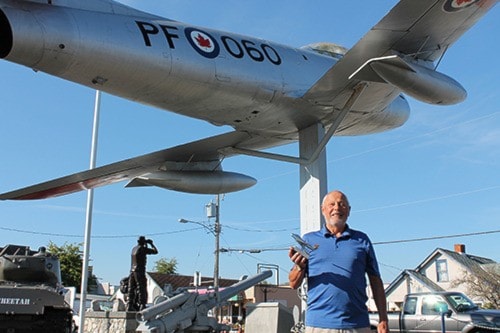During the early 1960s, powerful new jets were being flown in Canada and overseas by the military after decades of propeller aircraft that once dominated the sky. One pilot of such aircraft recalls high-stakes flying in Europe during the Cold War, passing so close to Soviet planes that one might have been able to wave hello.
You can see one of those jets – the F-86 Sabre – on display outside the Army, Navy and Air Force Veterans Association building in downtown Sidney. In fact, that jet aircraft was once a training aircraft and was flown by some of the best pilots the air force could muster.
One of those pilots is Saanich’s Dennis Jaques. He actually flew the Sabre that now sits atop a pole, a static display, in Sidney. Jaques and a group of his pilot colleagues gathered in Victoria this past weekend for a reunion of F-86 aviators. For him, when he discovered that he had actually flown the aircraft on display in Sidney, it brought back a lot of memories.
“I was in Sidney a while back and saw the number on the plane – 060,” Jaques told the PNR. “I checked in at the (ANAVETS) office and asked if it was a made-up number. Nope, they said, it was the real number.”
It was the same Sabre jet that Jaques flew during his training Chatham, New Brunswick in 1959.
Jaques, who lives in the Royal Oak area of Saanich these days, attended Royal Military College in Ontario in 1955. After he graduated in ’59, he was sent to Gimli, Manitoba for conversion training – from prop aircraft to jets.
“I started in Harvards and Chipmunks,” he said of the prop-driven aircraft he flew while at RMC.
He learned jet engines and how to fly them on T-33 aircraft in Manitoba. He would eventually be selected to train on what was then the state-of-the-art jets of their day, the F-86 Sabre.
“It was one of the best,” he recalled about the plane, noting that Canadian pilots of the day won awards among their allied forces using the Sabre.
It was a unique aircraft, he said. It was a fighter jet that used both machine guns and missiles – one of the last modern jets to rely almost exclusively on its cannons. These days, Jaques said, most jets rely on missiles to do the work.
After training in New Brunswick, Jaques said he was posted to 1 Fighter Wing in France. It was a stressful time, he said. The U.S. and the Soviets has squared off over Cuba and then, while he was in Europe, the Soviets cut off Berlin. The Berlin Crisis, said Jaques, saw the west airdrop supplies to people in the divided German city.
“We flew air combat patrols at 50,000 feet along the border of West Germany,” he said. “And the MiGs (Soviet jet aircraft) flew on the other side.”
He said he and his unit spent the entire summer of 1962 on alert – they had to be on the base, just in case.
During that time, he said neither side crossed the line, and there were no shots fired. A good thing, considering that a single incident could have turned the Cold War hot.
Jaques praised the Sabre for its performance at the time. It was a U.S.-built plane, modified with a Canadian engine. He said that allowed the jet to fly higher and faster – something he and his fellow pilots were very proud of. It would eventually be replaced by the CF-104.
Following his tour in Europe, Jaques was posted back in country to Ottawa for administrative work. He would eventually find himself with material command, working with computers. Jaques said he recalled the IBM computers they used at the time – all with 40K memory.
“You had to be very efficient when programming,” he laughed.
Jaques would retire from the military in the mid-1960s and would eventually retire for good in Saanich. Yet, he recalls his pilot days fondly and takes part in the odd Sabre pilots reunion, like this past weekend in Victoria. They happen every three to five years, he said, depending on who is doing the organizing. The previous one, he said, was held in Edmonton. They tell stories about their flying days – some true, some not-so-true. But there’s always someone there to set the story-teller straight.
“It’s a good remembrance,” Jaques said. “I tell my grandchildren when they ask, that flying the Sabre was like driving a Formula One race car.”
